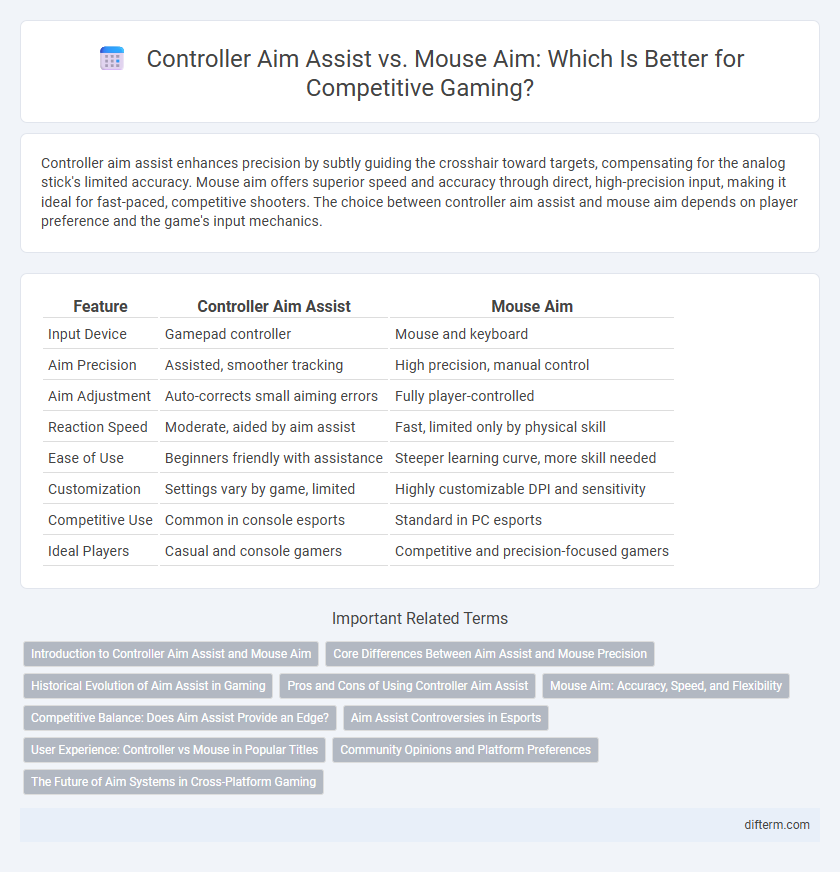Controller aim assist enhances precision by subtly guiding the crosshair toward targets, compensating for the analog stick's limited accuracy. Mouse aim offers superior speed and accuracy through direct, high-precision input, making it ideal for fast-paced, competitive shooters. The choice between controller aim assist and mouse aim depends on player preference and the game's input mechanics.
Table of Comparison
| Feature | Controller Aim Assist | Mouse Aim |
|---|---|---|
| Input Device | Gamepad controller | Mouse and keyboard |
| Aim Precision | Assisted, smoother tracking | High precision, manual control |
| Aim Adjustment | Auto-corrects small aiming errors | Fully player-controlled |
| Reaction Speed | Moderate, aided by aim assist | Fast, limited only by physical skill |
| Ease of Use | Beginners friendly with assistance | Steeper learning curve, more skill needed |
| Customization | Settings vary by game, limited | Highly customizable DPI and sensitivity |
| Competitive Use | Common in console esports | Standard in PC esports |
| Ideal Players | Casual and console gamers | Competitive and precision-focused gamers |
Introduction to Controller Aim Assist and Mouse Aim
Controller aim assist enhances precision by subtly guiding the controller's crosshair toward targets, compensating for the analog stick's lesser accuracy compared to mouse input. Mouse aim delivers superior raw accuracy and speed due to its direct, high-resolution sensor movements, favored in competitive first-person shooters. Understanding the benefits and limitations of each input method is crucial for optimizing gameplay strategies across different gaming platforms.
Core Differences Between Aim Assist and Mouse Precision
Aim assist in controllers leverages algorithms to subtly adjust aiming, enhancing target tracking and reducing input lag, while mouse precision relies on direct, high-resolution input for exact cursor movement. Controllers offer a smoother, more forgiving aiming experience through aim assist, which compensates for analog stick limitations and mechanical imprecision. Mouse aiming provides superior accuracy and faster response times, favored in competitive gaming for pixel-perfect targeting and rapid flick shots.
Historical Evolution of Aim Assist in Gaming
Aim assist in gaming debuted in the late 1990s with early console shooters like GoldenEye 007, designed to bridge the gap between controllers and mouse precision. Over the years, aim assist evolved through adaptive algorithms and dynamic magnetism to enhance player accuracy while preserving gameplay challenge across consoles. Recent iterations incorporate machine learning techniques to predict enemy movement, refining aim assist to closely mimic the precision of mouse aiming without compromising accessibility.
Pros and Cons of Using Controller Aim Assist
Controller aim assist enhances precision by slowing down crosshair movement near targets, which benefits players in fast-paced games or on consoles with lower sensitivity options. However, aim assist can create dependency, reducing skill development and precision compared to mouse aiming, which offers finer control and quicker target acquisition. Some players argue aim assist may lead to less competitive balance in cross-platform games, as it compensates for the controller's natural limitations but can feel inconsistent across different titles.
Mouse Aim: Accuracy, Speed, and Flexibility
Mouse aim offers superior accuracy, allowing gamers to make precise, pixel-perfect movements essential for competitive play. The speed of mouse input, characterized by swift and responsive tracking, enables quicker target acquisition and reaction times compared to controller aim assist. Flexibility in mouse settings, such as adjustable DPI and customizable sensitivity curves, provides players with personalized control, enhancing gameplay adaptability across various game genres and scenarios.
Competitive Balance: Does Aim Assist Provide an Edge?
Aim assist on controllers offers subtle targeting help by slightly slowing down crosshair movement near enemy models, which can level the playing field against mouse users with higher precision. Despite this, skilled mouse players maintain a competitive edge due to finer aim control and quicker reaction times. Game developers often tweak aim assist strength to balance competitive integrity in esports titles like Apex Legends and Call of Duty.
Aim Assist Controversies in Esports
Aim assist controversies in esports revolve around whether controller players gain unfair advantages when competing against mouse users. Critics argue that aim assist skews skill-based competition by artificially enhancing controller accuracy, while proponents claim it offers necessary balance due to hardware differences. Tournament rules and game developers continue to adapt settings and enforce policies to address these disparities and maintain competitive integrity.
User Experience: Controller vs Mouse in Popular Titles
Controller aim assist enhances precision and smoothness in fast-paced games by compensating for joystick sensitivity limitations, offering a more accessible experience for casual players. Mouse aim delivers superior accuracy and quicker reaction times due to higher sensitivity and granular control, favored in competitive titles like Call of Duty and Valorant. Popular games often balance aim assist strength to maintain fairness and cater to diverse player preferences, influencing overall user satisfaction across platforms.
Community Opinions and Platform Preferences
Controller aim assist remains popular among console gamers, with many appreciating its role in leveling the playing field against mouse and keyboard users. The PC gaming community largely favors mouse aim for its precision and responsiveness, viewing it as a skill-based advantage. Platform preferences highlight a divide where controllers dominate on consoles, while mouse and keyboard setups are standard on PC, shaping distinct competitive dynamics and player experiences.
The Future of Aim Systems in Cross-Platform Gaming
Controller aim assist leverages algorithms to predict player intent and smooth targeting, enhancing precision on consoles and making competitive play viable against mouse users. Mouse aim offers unparalleled accuracy and speed due to direct input tracking, often favored in high-skill esports environments. Emerging aim systems integrate adaptive aim assist with customizable sensitivity curves to balance fairness across cross-platform games, driving innovations that blur the line between controller and mouse performance.
Controller Aim Assist vs Mouse Aim Infographic

 difterm.com
difterm.com